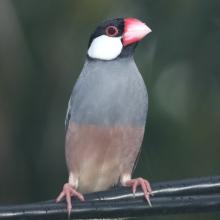Lonchura oryzivora

Conservation Status:
Vulnerable on the IUCN Red List.
Range:
Native to Indonesia. Introduced to other areas, including Hawaii, parts of Africa, Japan, China, and the Caribbean
Habitat:
Open woodlands, often bordering cultivated areas, mangroves, grassland, and human settlements
Java Sparrows primarily feed on grains and seeds. Their binomial Latin name, Lonchura oryzivora, translates to "rice paddy eater" because a flock of Java Sparrows can consume a significant amount of rice. Their flocks can exceed 200 individuals!
They construct nests from grass in bushes and tree cavities. They lay large clutches of 4 to 8 eggs. Incubation lasts approximately 14 days. The chicks are altricial (nearly helpless and dependent on parental feeding and care) and take a relatively long period of 2 to 3 weeks to fledge.
Due to habitat loss and hunting, Java Sparrows are considered Vulnerable on the IUCN Red List. Without intervention, they are at risk of becoming Endangered.
On the other hand, Java Sparrows have been introduced to other tropical regions where they compete with native species for food. They are one of the few species in the world that are Vulnerable while also expanding their range.
